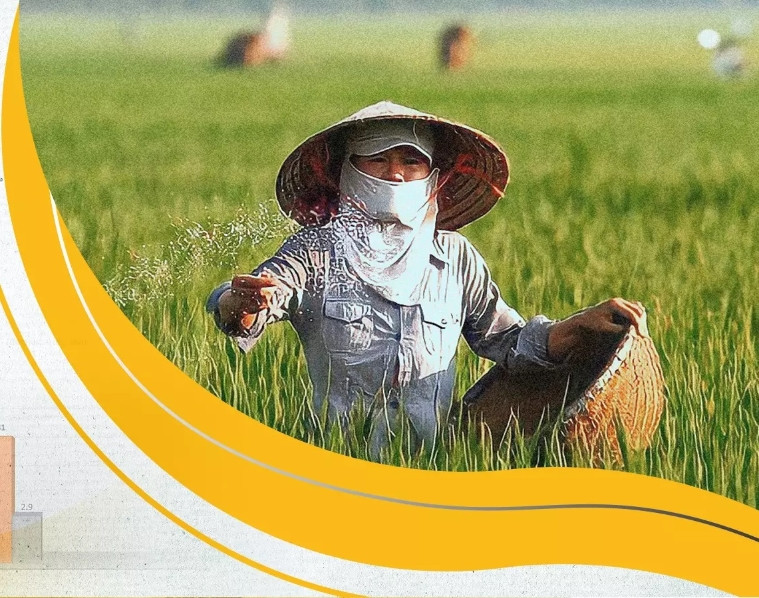
Having to sell dragon fruit at cheap prices and suffering a loss of VND7,000-9,000 per kilo because the fruit cannot be exported to China, Mr. Nguyen Van Phung, a dragon fruit grower in the central province of Binh Thuan has been doubly hit by the rise in fertilizer price.
For more than 10 years growing dragon fruit, Phung has never faced such difficulty as input prices are rising and output falling dramatically.
The Russia - Ukraine conflict has pushed up fertilizer prices globally. The price of this item in the domestic market has reached its peak over 50 years, pushing millions of Vietnamese farmers like Mr. Phung into a crisis as Vietnam is heavily dependent on imported fertilizers.
Fertilizer prices rocket
According to the Plant Protection Department (Ministry of Agriculture and Rural Development), Vietnam uses an average of over 10 million tons of industrial fertilizers annually. In 2020, and used 10.23 million tons of fertilizer produced by fertilizer factories, including 7.6 million tons of inorganic fertilizers and 2.63 million tons of organic fertilizers. In addition, there were about 17 million tons of organic fertilizer produced by farmers for their own use.
In 2021, the amount of industrial fertilizer used was 10.7 million tons, an increase of 4.67% compared to 2020, including 7.81 million tons of inorganic fertilizer, up 2.78%, and nearly 2.9 million tons of organic fertilizer, up by 262,685 tons, equivalent to an increase of 10% compared to 2020.
Local fertilizer factories can only meet the demand for phosphate, Urea, NPK fertilizers and about 60% of demand for DAP fertilizer. Potassium and SA fertilizers depend entirely on imported sources. Organic fertilizers meet domestic and export demand without having to depend on imported raw materials.
Data of the General Department of Customs shows that Vietnam’s fertilizer imports have increased sharply. Specifically, in 2019, the country imported 3.7 million tons of fertilizer and 3.8 million tons in 2020, 5.1 million tons in 2021. In the first two months of 2022, the volume of imported fertilizers reached 706,769 tons, including 248,941 tons of Potassium fertilizer, accounting for 35.2%; and 184,737 tons of SA fertilizer, accounting for 26.1%.
The Plant Protection Department said that fertilizer prices increased sharply in 2021. This year, the conflict between Russia and Ukraine has had a strong impact on fertilizer supply and prices in the world.
Immediately after the conflict occurred on February 24, the world fertilizer price immediately soared by 8-12% compared to the previous day because Russia is one of the world's leading fertilizer suppliers. In 2021, Russia ranked first in the world in exporting urea, NPK, and ammonium nitrate, 3rd in potassium and 4th in phosphate in the world.
Currently, Russia is also a major fertilizer supplier to Vietnam. In 2021, the amount of fertilizer imported from Russia amounted to 320,045 tons, worth US$123.5 million. Vietnam mainly imports potassium, NPK, and DAP fertilizers from this market.
The average import price of fertilizers in the first two months of 2022 jumped to $480.7/ton, up 85% over the same period last year.
Fertilizer prices peak, farmers face crisis
Currently, the cost of fertilizers account for 40-60% of the total input costs in agricultural production.
These days, fertilizer prices have peaked in the past 50 years. According to the Department of Agricultural Product Processing and Market Development (MARD), in February 2022, the average retail price of most fertilizers continued to rise compared to the previous month. The price for seven of the eight major fertilizers has increased.
Most fertilizers have higher prices compared to a year earlier. The price for MAP is now 44% more expensive, DAP 46% higher, 10-34-0 60% higher, urea 95%, potassium 102% up, UAN32 144%, UAN28 146% up and anhydrous 181% up over last year.
It is forecast that there will be a serious shortage of DAP 64% in the second quarter and the domestic price will increase to VND25 million/ton.
For potassium fertilizer, as Vietnam imports 100% of this product, the price of this item will rise to VND15-16 million/ton for flour and VND18-20 million/ton for flakes.
This also means that millions of farming households in Vietnam will face a crisis when the cost of fertilizers makes up 40-60% of the total input costs in agricultural production.
Experts recommend that, in order to best adapt in the current context, farmers need to promote the application of new technical advances to reduce the amount of fertilizer, using organic fertilizers to partially replace inorganic fertilizers.
According to statistics, Vietnam has a supply of agricultural by-products up to 156 million tons per year. Most of the by-products can be used as organic fertilizer, but only a small amount has been used. If Vietnam can take advantage of this source of raw materials, it can reduce fertilizer imports and at the same time lower production costs.
Tam An